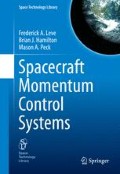Abstract
This chapter provides the analysis tools and fundamental theory for the design of an array architecture consisting of momentum devices. First, the properties of the actuator alignments and their effect on shaping the performance envelope of the momentum-control system are discussed. A survey of common array types for RWA, CMG, and mixed arrays follows. A discussion of performance metrics and methods used to optimize the array architecture concludes the chapter.
Notes
- 1.
The avoidance of SGCMG singularities for an array of two or more VSCMGs with linearly independent gimbal axes assumes that the rotors do not reach their maximum speed or zero. With sufficiently many rotors at maximum speed, the array can no longer provide rotor accelerations to aid in SGCMG singularity avoidance. Similarly, when enough rotors have very little momentum, the gyroscopic torque vanishes, worsening the singularities.
References
F. Markley, R. Reynolds, F. Liu, K. Lebsock, Maximum torque and momentum envelopes for reaction wheel arrays. AIAA J. Guid. Control. Dyn. 33(5), 1606 (2010)
W. Chubb, H. Kennel, C. Rupp, S. Seltzer, Flight performance of skylab attitude and pointing control system. AIAA J. Spacecr. Rocket. 12(4), 220 (1975)
M. Carpenter, M. Peck, Reducing base reactions with gyroscopic actuation of space-robotic systems. IEEE Trans. Robot. 25(6), 1262 (2009)
D. Cunningham, G. Driskill, A torque balance control moment gyroscope assembly for astronaut maneuvering, in NASA. Ames Research Center 6th Aerospace Mechanics Symposium (SEE N72-26377 17-15), 1972, pp. 121–126
”C-1 - Lit Motors.” Lit Motors C1 (2013), http://litmotors.com/c1/. Accessed 13 Sept 2015.
H. Kurokawa, A geometric study of single gimbal control moment gyros (singularity problems and steering law). Technical Report 175, Agency of Industrial Technology and Science, Japan, 1998
J. Rodden, Attitude control system lectures. Lecture Notes (1980)
E. Tokar, V. Platonov, Singular surfaces in unsupported gyrodyne systems. Cosm. Res. 16, 547 (1979)
H. Kurokawa, Survey of theory and steering laws of single-gimbal control moment gyros. AIAA J. Guid. Control. Dyn. 30(5), 1331 (2007)
T. Sands, J. Kim, B. Agrawal, 2h singularity-free momentum generation with non-redundant single gimbaled control moment gyroscopes, in 45th IEEE Conference on Decision and Control, 2006, pp. 1551–1556
H. Yoon, P. Tsiotras, Singularity analysis of variable-speed control moment gyros. AIAA J. Guid. Control. Dyn. 27(3), 374 (2004)
M. Karpenko, S. Bhatt, N. Bedrossian, I. Ross, Flight implementation of shortest-time maneuvers for imaging satellites. AIAA J. Guid. Control. Dyn. 37(4), 1069 (2014)
I. Ross, M. Karpenko, A review of pseudospectral optimal control: from theory to flight. Annu. Rev. Control. 36(2), 182 (2012)
H. Kojima, Singularity analysis and steering control laws for adaptive-skew pyramid-type control moment gyros. Elsevier Acta Astronaut. 85, 120 (2013)
J.J. Bonn, M.A. Peck. Dynamic cmg array and method. US Patent 7,561,947, 2009
D. Cornick, Singularity avoidance control laws for single gimbal control moment gyros, in AIAA Guidance, Navigation and Control Conference, 1979
H. Schaub, J. Junkins, CMG singularity avoidance using VSCMG null motion (variable speed control moment gyroscope), in AIAA/AAS Astrodynamics Specialist Conference and Exhibit, Boston, MA, 1998, pp. 213–220
J. Roes, Electro-mechanical energy storage system for space application. Prog. Astronaut. Aeronaut. 3 (1961)
V. Babuska, S. Beatty, B. deBlonk, J. Fausz, A review of technology developments in flywheel attitude control and energy transmission systems, in Proceedings of the IEEE Aerospace Conference, vol. 4, 2004
J. Notti, A. Cormack, W. Klein, Integrated power/attitude control system (ipacs). AIAA J. Spacecr. Rocket. 12(5), 485 (1975)
J. Fausz, D. Richie, Flywheel simultaneous attitude control and energy storage using a vscmg configuration, in Proceedings of the 2000 IEEE International Conference on Control Applications, 2000, pp. 991–995
P. Tsiotras, H. Shen, C. Hall, Satellite attitude control and power tracking with energy/momentum wheels. AIAA J. Guid. Control. Dyn. 24(1), 23 (2001)
H. Yoon, P. Tsiotras, Singularity analysis and avoidance of variable-speed control moment gyros–part ii: power constraint case, in AIAA Guidance, Navigation, and Control Conference, Providence, RI, 2004
K.L. McLallin, R.H. Jansen, J. Fausz, R.D. Bauer, Aerospace flywheel technology development for ipacs applications. Technical Report TM-2001-211093, NASA, 2001
G. Leve, F. Boyarko, N. Fitz-Coy, Optimization in choosing gimbal axis orientations of optimization in choosing gimbal axis orientations of a cmg attitude control system, in AIAA Infotech@Aerospace Conference, Seattle, WA, 6–10 April 2009
Author information
Authors and Affiliations
Rights and permissions
Copyright information
© 2015 Springer International Publishing Switzerland
About this chapter
Cite this chapter
Leve, F.A., Hamilton, B.J., Peck, M.A. (2015). Momentum-Control System Array Architectures. In: Spacecraft Momentum Control Systems. Space Technology Library, vol 1010. Springer, Cham. https://doi.org/10.1007/978-3-319-22563-0_6
Download citation
DOI: https://doi.org/10.1007/978-3-319-22563-0_6
Publisher Name: Springer, Cham
Print ISBN: 978-3-319-22562-3
Online ISBN: 978-3-319-22563-0
eBook Packages: EngineeringEngineering (R0)

